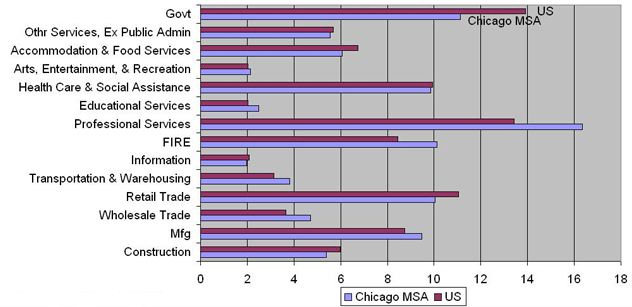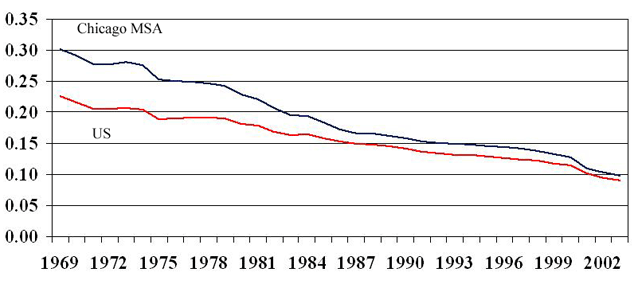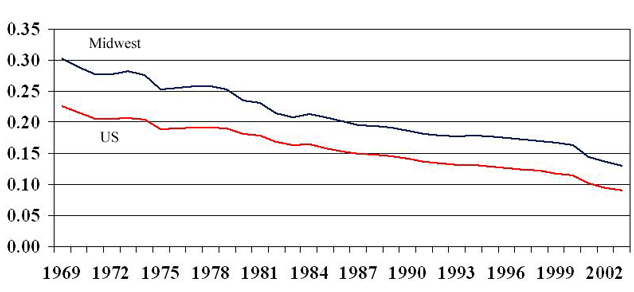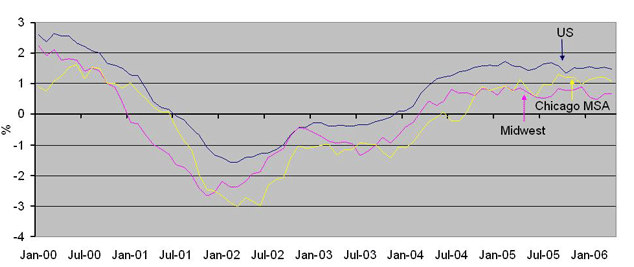Hog Butchers No Longer?
In his description of Chicago, Carl Sandburg poetically referred to it as the “city of the big shoulders … stacker of wheat … tool maker … player with the railroads … hog butcher.” At the time, this description fit Chicago’s economy just right as a place of muscular blue-collar industries such as rail freight, steel making, and meat packing. But today, Chicago’s economy has morphed into a city of more genteel, white-collar professions and industries. Infrastructure, such as a global airport and a significant broadband communications capacity, have helped to develop industries that are knowledge-based rather than commodity-based. The chart below compares the Chicago metropolitan area’s employment with the nation’s across broad industry sectors. The bars measure the share of total employment in a given industry so that, for example, the top maroon bar illustrates that 14 percent of U.S. employment can be found in government sectors, while 11 percent of the Chicago area employment can be found in government sectors (purple bar).
1. Industry share of total employment, 2004

The purple bar that illustrates Chicago’s long suit is “professional services.” Most of these industries are business services, including accounting, management consulting, advertising, temporary services, legal, and research and development. To a large degree, these industries are staffed by educated professionals. In comparison to the overall nation (maroon bar), Chicago’s economy is more highly concentrated in these industries. The same can be said for the finance, insurance, and real estate (FIRE) sector comparison that can be found below professional services on the chart. The FIRE group includes Chicago’s world-leading risk exchanges and related businesses.
To staff its new economy, many young and educated workers are migrating to Chicago, especially from surrounding states. In addition to career opportunities, they are attracted by amenities such as lakefront parks, renovated neighborhoods, lively nightlife, operas, ballet, and orchestras. In a recent news article, journalist David Greising playfully rewrote Sandburg’s poetic ode to Chicago to reflect its new economy: “Hog belly trader for the World, Writ Writer, Consultee of Companies, Builder of Airports, and the Nation’s Intermodal Carrier, Prideful, Anxious, Hopeful, City of the Stringed Orchestra.”
The service orientation of Chicago’s economy has come about in a remarkably short time. It was not so long ago that Chicago’s employment concentration closely resembled the surrounding Midwest economy, especially its sharp concentration in manufacturing employment. The chart below tracks the manufacturing share of Chicago’s economy from 1969 onward and compares it to the overall U.S. As recently as 1969, both Chicago and the surrounding Midwest were significantly more concentrated in manufacturing jobs than the U.S. But steadily over time, Chicago’s concentration has converged with the U.S., while the Midwest as a whole has maintained a higher proportion of jobs in manufacturing.
2. Manufacturing share of total nonfarm employment — Chicago MSA and U.S.

3. Manufacturing share of total nonfarm employment — Midwest and U.S.

What does Chicago’s divergence from the Midwest mean for its economic performance and prospects? For one, it means that Chicago may maintain a healthy pace of population and income growth although it is shedding manufacturing jobs at a rapid clip. In comparison, other Great Lakes manufacturing cities such as Buffalo, Cleveland, Detroit, and Milwaukee have not been as successful in replacing lost manufacturing jobs with high-end services.
But this performance does not necessarily mean that the Chicago region has cut loose its ties to the surrounding Midwest economy. During the 1990s, many observers hailed Chicago’s strong economic performance as an indication of its arrival as a global city rather than as a midwestern city, a city with strong trading linkages beyond the immediate region. However, over the past 5 years, Chicago’s employment growth has slipped to a tepid pace of approximately one-half the nation’s, which is much like the pace of the overall Midwest. Even the performance of its business service sector has been lagging. Could it be that Chicago’s service sectors continue to sell to surrounding Midwest businesses such as agriculture and manufacturing rather than to the nation and the world?
4. Payroll job growth, year-over-year, SA

The answer to this question is important in assessing Chicago’s growth prospects. The answer is far from crystal clear. In part, Chicago remains and will remain the commercial center of the surrounding Midwest for many years to come. And so, the sagging fortunes of Michigan’s automotive companies to Chicago’s east will likely be felt in the capital markets and consulting offices of Chicago. However, it is also the case that many Chicago business activities are now broadening out farther afield to global markets. For example, Chicago’s risk exchanges and its world-class universities are aggressively extending business lines and services to Asia.
So too, the recent slowing in Chicago’s economic performance may reflect some special developments that are not likely to be repeated. In particular, business travel is a key service activity of Chicago’s economy that was stiffly impacted by the national business slowdown in 2001-2004 and especially by the 9-11 air travel slowdown. At the same time, the national post-Y2K decline in computer and computer-system investment likely impacted business consulting companies in Chicago as well.
More generally, many business and professional services are purchased for the same reasons and with the same timing as capital investment. That is, as the capacity of firms begin to be stretched thin during times of ongoing economic expansion, firms once again purchase business services and capital equipment alike in order to expand production capacity and to find and serve expanding markets. In turn, the strong business investment that has been taking place in the U.S. economy should continue to be felt in the office buildings of the Chicago economy.








